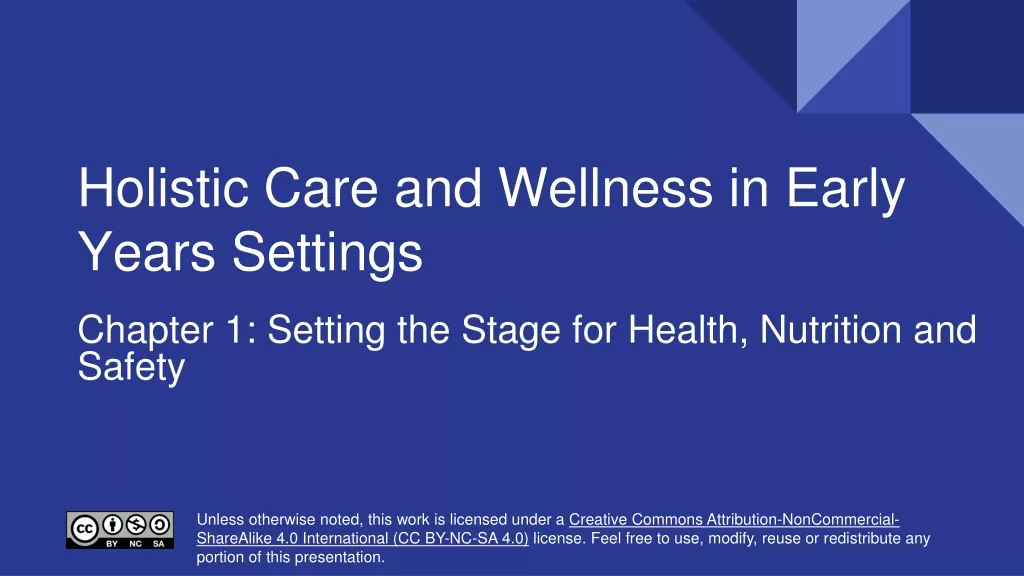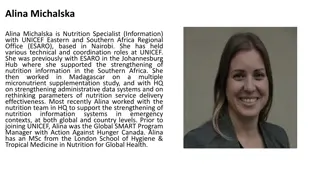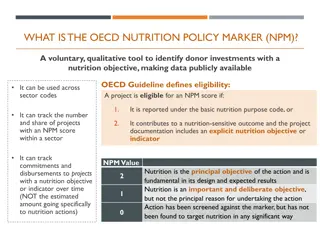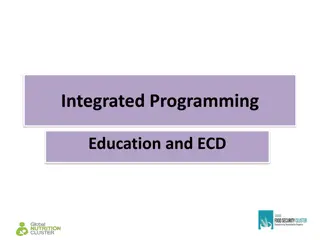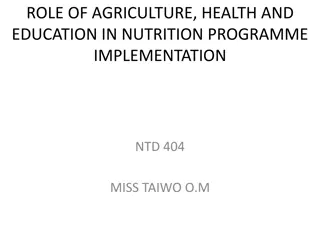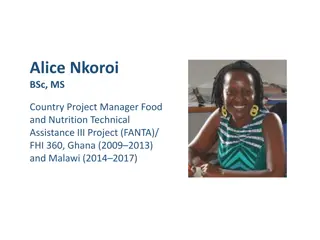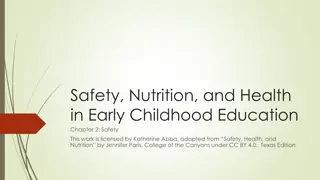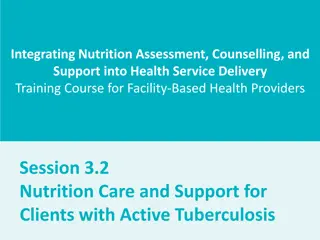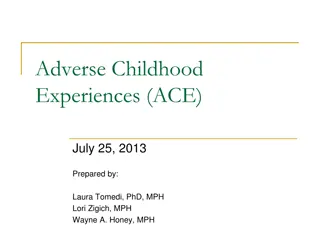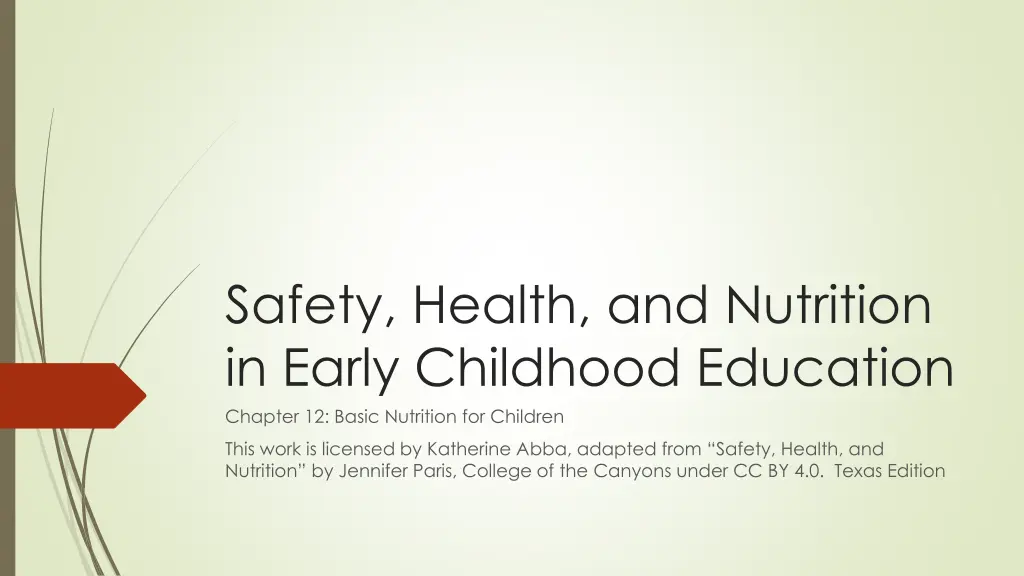
Understanding Children's Nutritional Needs and Macronutrients
Explore the essential information on children's nutritional needs, classes of nutrients, and macronutrients like carbohydrates. Learn how nutrients support basic body functions and the importance of a balanced diet in early childhood education.
Download Presentation

Please find below an Image/Link to download the presentation.
The content on the website is provided AS IS for your information and personal use only. It may not be sold, licensed, or shared on other websites without obtaining consent from the author. If you encounter any issues during the download, it is possible that the publisher has removed the file from their server.
You are allowed to download the files provided on this website for personal or commercial use, subject to the condition that they are used lawfully. All files are the property of their respective owners.
The content on the website is provided AS IS for your information and personal use only. It may not be sold, licensed, or shared on other websites without obtaining consent from the author.
E N D
Presentation Transcript
Safety, Health, and Nutrition in Early Childhood Education Chapter 12: Basic Nutrition for Children This work is licensed by Katherine Abba, adapted from Safety, Health, and Nutrition by Jennifer Paris, College of the Canyons under CC BY 4.0. Texas Edition
Textbook Objectives micronutrient. Define and explain the function of each macronutrient and type of Examine factors that affect the quality of food. Discuss influences on food choice. Outline how to achieve a healthy diet. programs. Describe programs that support nutrition in early care and education education programs. Identify ways to assess the quality of meals and snacks in early care and
HCC Learning Outcomes 3. Analyze principles of nutrition and the application to nutritional assessment. 3.4 Compare nutritional guidelines and regulations. 3.5 Identify policy and regulatory requirements for nutrition. 4.Identify policy and regulatory requirements for nutrition.
Childrens nutrition needs Food contains nutrients. Nutrients are substances our body needs to perform basic functions (breathing, moving, digestion, etc.). Nutrients are obtained from the foods we eat, because we cannot synthesize or produce them from foods. Nutrients provide energy, contribute to body structure, and/or regulate chemical processes in the body.
Classes of nutrients There are six classes of nutrients required for the body to function and maintain overall health: What are they? List all six, below:
Macronutrients Macronutrients are the nutrients needed in large amounts. These are carbohydrates, fats, and proteins and they allow our bodies to conduct their basic functions. Calorie= A unit of measurement of food energy, needed to conduct basic functions of the body. Water is also a macronutrient, but it does not yield calories.
Carbohydrates Carbohydrates molecules composed of carbon, hydrogen, and oxygen. They are soluble in water. The major food sources of carbohydrates are grains, milk, fruits, and starchy vegetables. Non-starchy vegetables also contain carbohydrates, but in lesser quantities. Carbohydratres provide energy, serve as building blocks for larger macromolecules and contribute to the healthy functioning of the nervous system, heart, and kidneys. (Paris, 2020) Carbohydrates are broadly classified into two form: simple carbohydrates, often called simple sugars; and complex carbohydrates. Examples of simple carbohydrates are:? Complex carbohydrates are: ?
Fats Fats, also known as lipids, are also molecules composed of carbon, hydrogen, and oxygen. They are not soluble in water. Fats provide or store energy. Fats provide more energy per gram than carbohydrates. Fats serve as a major component of cell membranes, surround and protect organs, provide insulation to aid in temperature regulation, and regulate many other functions in the body (Paris, 2020, p.298). Fats can be found in what foods?
Proteins Proteins are macromolecules composed of amino acids. Proteins provide energy, but, primarily, proteins provide structure to bones, muscles and skin, and play a role in conducting most of the chemical reactions that take place in the body (Paris, 2020). Food sources of protein are: ?
Water Water is a nutrient we need in large quantities. Water is responsible for transporting substances in and out of the body, chemical reactions, providing cushioning for our organs, and regulating body temperature.
Micronutrients Micronutrients are nutrients required in small amounts, but are critical to carrying out bodily functions (Paris, 2020). Micronutrients include all of the 16 essential minerals and vitamins. Micronutrients aid in producing energy, digesting nutrients, and building macromolecules . The function of minerals?- examples of minerals? The function of vitamins?- examples of vitamins?-
Quality of food What are nutrient-dense foods? Are vitamins nutrient-dense foods? Can vitamins take the place of eating nutrient-dense, high quality foods?
Factors that Drive Food Choices Your environment and lifestyle can influence the foods you eat. What else influences our food choice?
Type of Vegetarian Diets Complete the chart below: ? Diet Lacto-ovo vegetarian Yes Lacto-vegetarian Ovo-vegetarian Vegan Consumes Eggs Consumes Dairy Products No No (no animal products)
A healthful diet There are five key factors that make up a healthful diet. They are? Which factors influence YOU the most?
Child and Adult Care Food Program Different programs in the United States support early care and education programs in providing nutritious meals and snacks for children. The Child and Adult Care Food Program (CACFP) is one of those. https://www.fns.usda.gov/cacfp What are 3 facts about this program? 3 of their best practices recommendations?
Healthy Beverages in Child Care Act The 4 key messages for the Healthy Beverages in Child Care Act are?
Dietary Guidelines for Americans The Dietary Guidelines for Americans, produced by HHS and the U.S. Department of Agriculture every five years, analyze the latest research to help Americans make smart choices about food and physical activity so they can live healthier lives. How are their recommendations different from the CACFP recommendations?
There are five overarching guidelines 1. Follow a healthy eating pattern across the lifespan. Eating patterns are the combination of foods and drinks that a person eats over time. 2.? 3.? 4.? 5.?
Dietary Reference Intakes (DRI) Issued by the Food and Nutrition Board of the Institute of Medicine, National Academy of Sciences, the DRI is the general term for a set of reference values used to plan and assess nutrient intakes of healthy people (Paris, 2020, p. 315). The values are: ?
A color-coded example nutrition facts label for lasagna* *https://www.fda.gov/food/nutrition-education-resources-materials/how-understand-and-use-nutrition- facts-label
Label facts What are 4 important information provided on the nutrition facts labels?
Child Nutrition Programs for Schools Feeding the Gulf Coast https://www.feedingthegulfcoast.org/learn-more/our-programs/child- nutrition-programs The federal government provides federal assistance to schools to provide nutritious meals to children. There are 4 such programs. List and briefly describe each, below:


